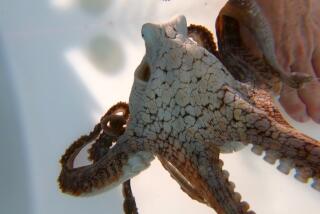Save the Dolphins From Hypocrisy
- Share via
April 29, 1999: The Commerce Department, pursuant to a law passed in 1997, announced support for changing the popular “dolphin safe” label on cans of tuna sold in the United States. Under the new ruling, fish caught by the previously banned purse seine net method--by which fishermen encircle and harass dolphins--could now be termed “dolphin safe” even though dolphins would be chased down, caught in the nets, harassed and injured.
May 28, 1999: The same Commerce Department declares that feeding and swimming with dolphins is illegal. According to the department’s National Marine Fisheries Service, “The best way to protect dolphins is to observe the animals at a respectful distance of at least 50 yards and resist feeding them. In addition, people need to avoid any activities that risk harassment of dolphins, such as chasing, touching or swimming with the animals.”
Run that by us again? Hunting down, chasing, encircling and harassing dolphins in tuna nets doesn’t necessarily have a significant adverse impact on dolphins, so it’s fine for fishermen to engage in these activities and call their resulting tuna catches “dolphin safe?” But slipping Flipper a herring or patting his nose is “harassment” and could be “harmful?”
This disturbingly contradictory position has nothing to do with what is safe for the still-depleted dolphin populations. It has everything to do with international trade, and specifically with the weakening of U.S. environmental laws to satisfy international economic partners, an outcome we warned about when trade and environmental standards were kept out of the North American Free Trade Agreement and other pacts.
The dolphin-safe law we wrote in 1990 was designed to bar the sale of tuna in the U.S. that had been caught using techniques that resulted in massive losses of dolphins. In the years preceding its enactment, Pacific dolphin stocks had plummeted because tuna fishermen set their nets on the marine mammals that often swim with the tuna schools. When the fishermen encircled the tuna in their gigantic purse seine nets, they caught and killed thousands of dolphins, too.
Since passage of our law, dolphin deaths have gone from more than 80,000 to fewer than 3,000 a year. So why argue with success? The Clinton administration, pressed by foreign tuna fleets who, unlike the U.S. fishermen continue to use purse seine netting, capitulated in 1997 and agreed to legislation that allows tuna caught using purse seine nets to be sold in the U.S. and labeled “Dolphin safe,” unless scientists could prove it was the fishing technique that was hurting dolphin populations. Now, data from the Inter-American Tropical Tuna Commission show that decimated dolphin populations are not showing significant recovery signs. One stock associated with tuna fishing appears to be in continued decline. Commerce Department scientists acknowledge depleted dolphin stocks have shown no significant improvement.
But scientists cannot say that the continued poor quality of dolphin stocks is specifically due to fishing, although we certainly can say that the mammal populations have not improved in light of the continued use of purse seine techniques by Mexican and other fleets. And so lacking that definitive proof, the Commerce Department has decided to throw open the shelves of America’s supermarkets to tuna bearing a “dolphin safe” label even though dolphins most assuredly were harassed, encircled, entangled, hauled up onto fishing boats and injured.
With the consent of a Republican Congress, the administration is ignoring science and showing a callous disregard for the plight of a dolphin population that continues to decline. And it is deceiving consumers by leading them to believe that cans of tuna bearing the “dolphin safe” label will continue to connote concern for the welfare of dolphins.
Sorry, Charlie. This dual policy just doesn’t cut it. Fishermen can subject dolphins to severe stress and injury and enjoy the government’s seal of safety, but a citizen touching a dolphin swimming near their boat is subject to up to a $100,000 fine for endangering the creature.
The Commerce Department’s decision should be reversed, allowing us to maintain the integrity of the label that, since its introduction in the early 1990s, has only been allowed on tuna that was not harvested using the techniques known to kill dolphins.
More to Read
Sign up for Essential California
The most important California stories and recommendations in your inbox every morning.
You may occasionally receive promotional content from the Los Angeles Times.













